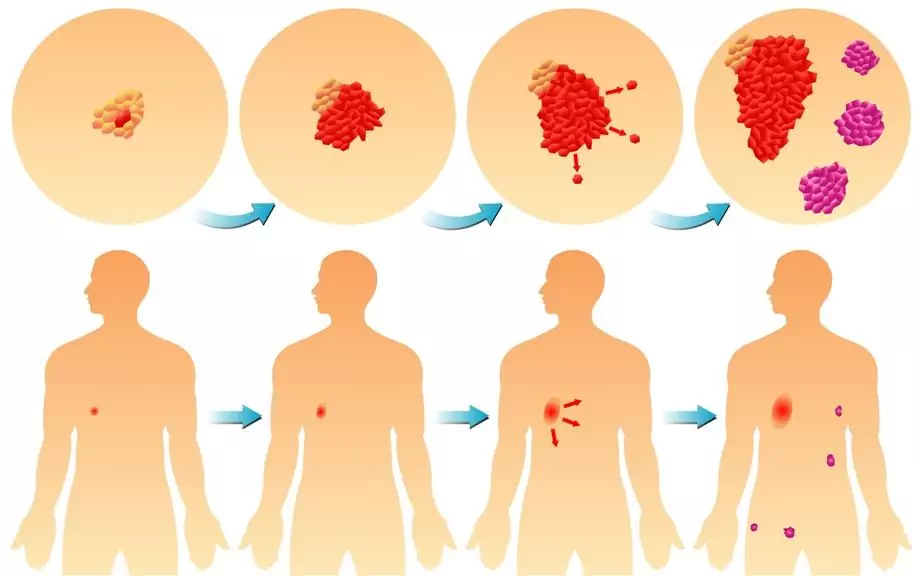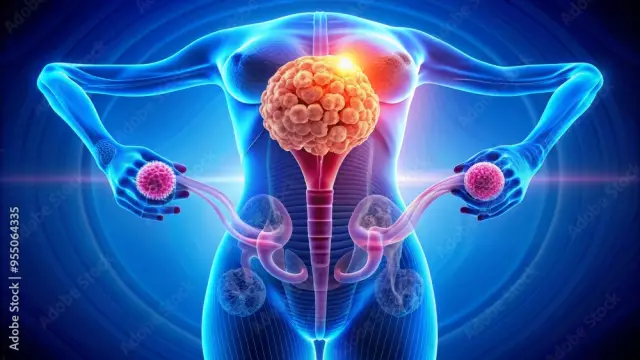- Author Rachel Wainwright [email protected].
- Public 2023-12-15 07:39.
- Last modified 2025-11-02 20:14.
Malignant tumor
The content of the article:
- Causes and risk factors
- Forms of the disease
- Degrees
- Symptoms
- Diagnostics
- Treatment
- Possible complications and consequences
- Forecast
- Prevention
A malignant tumor is an autonomous pathological progressive process that is not provided for by the plan for the structure and functioning of the body and is an uncontrolled multiplication of cells that are distinguished by their ability to colonize surrounding tissues and metastasize.

The development of a malignant tumor
A malignant neoplasm is characterized by atypism, that is, the loss of the characteristics of normal tissues. Atypism is noted at various levels: biochemical (altered metabolic processes), antigenic (a kind of set of antigens that is not typical of normal cells and tissues), morphological (characteristic structure), etc.
The very definition of a malignant tumor contains the idea of significant (sometimes fatal) harm to the human body. The term "cancer" for the designation of a malignant tumor was first used by Hippocrates (ancient Greek καρκίνο «-" crab "," cancer ") due to the external similarity of the growing neoplasm with cancer, which has spread its claws. He also described the first tumors and made an assumption about the need for their complete removal with access.
More than 10 million people are diagnosed with malignant neoplasms in the world every year; in the structure of mortality, these diseases are in second place after cardiovascular pathology. The most common form of cancer is lung cancer, followed by breast cancer.
In Russia, the annual morbidity is approximately 500 thousand people, about 3 million patients (approximately 2% of the population) are registered for malignant neoplasms. In recent decades, there has been a clear trend towards an increase in the number of oncological diseases.
Causes and risk factors
There are several theories regarding the causes and mechanisms of the development of malignant tumors:
- physicochemical (Virchow theory);
- dysontogenetic (Kongheim);
- viral genetic (Zilber);
- immunological (Burnet);
- polyetiological (Petrova).
Physicochemical theory explains the development of malignant tumors as a result of the effects on the body of various exo- and endogenous carcinogens, systematic injury. The highest carcinogenic activity is possessed by aggressive chemicals, ionizing radiation, some products of its own metabolism (metabolites of tryptophan and tyrosine), ultraviolet radiation, components of tobacco smoke, aflatoxins, etc. The effect of these substances on a cell in certain doses leads to damage to its genetic apparatus and malignant transformation. The development of malignant tumors in places of constant friction and habitual trauma is possible.
The dysontogenetic model of the development of malignant tumors (the theory of embryonic rudiments) was first proposed by Yu. F. Kongheim. It implies the occurrence of cellular and tissue malformations in the embryonic period, which further leads to the active multiplication of atypical cells that form tumors. According to this theory, during embryogenesis, in some parts of the body, an excess number of cells are formed, which are "unnecessary" in an inactive state. Latent cell formations have a significant growth potential inherent in embryonic tissues, which explains the active malignant growth in a situation of accidental activation of dormant structures.
The viral-genetic theory assigns a leading role in the development of tumors to the effects of oncogenic viruses, which include, for example, herpes viruses (including Epstein-Barr viruses), papillomaviruses, hepatitis viruses, human immunodeficiency viruses, T-cell leukemia virus, etc. particles inside a normal cell, their genetic apparatuses are combined. The host cell begins to function as a collector of the components of the virus, producing the elements necessary for its vital activity. At this moment, malignant degeneration of normal cells of the body often occurs, uncontrolled cell proliferation is triggered; the presence of the virus ceases to play a decisive role in carcinogenesis, and the process becomes irreversible.

According to the viral genetic theory, malignant tumors arise under the influence of oncogenic viruses
Burnet's immunological theory calls a malignant tumor formation provocateur as a malfunction of the immune system (damage to immunological surveillance), in which it loses its ability to recognize and destroy altered atypical cells, which leads to their rapid uncontrolled growth.
The polyetiological approach to explaining the development of malignant tumors presupposes a combined effect on the normal structures of the body of many provoking factors, which leads to their damage and further degeneration.
As a result of provoking influences, a failure of the natural anti-cancer defense system develops, the functioning of which is ensured by the following components:
- anticarcinogenic mechanism responsible for the neutralization of potentially dangerous agents;
- anti-transformation mechanism that prevents malignant degeneration of normal cells and tissues;
- anticellular mechanism, which consists in the timely removal of malignant cells and normal cells of the body that have undergone malignancy.
As a result of damage to the antitumor defense system or excessive exposure to provoking factors, malignant neoplasms are formed.
Forms of the disease
Depending on the tissues from which the tumor originates, the following forms of malignant neoplasms are distinguished:
- epithelial organ-nonspecific (in places of atypical localization of epithelial tissue);
- epithelial organ-specific (exo- and endocrine glands, body integuments);
- mesenchymal;
- melanin-forming tissue;
- nervous system and membranes of the brain and spinal cord;
- hematopoietic and lymphatic tissues (hemoblastosis);
- formed from embryonic tissues.
Types of tumors according to the types of original cells:
- carcinoma (cancer itself) - epithelial cells;
- melanoma - melanocytes;
- sarcoma - connective tissue cells;
- leukemia - blood-forming cells of the bone marrow;
- lymphoma - lymphatic cells;
- teratoma - gonocytes;
- glioma - neuroglia cells;
- choriocarcinoma - trophoblast cells.

Common types of malignant tumors in women and men
The types of cancer itself (carcinoma) are distinguished depending on the type of epithelial tissue from which it originates and the structural features:
- squamous (without keratinization, with keratinization);
- adenocarcinoma;
- cancer in situ (in situ);
- solid (trabecular);
- fibrous;
- medullary;
- slimy;
- small cell.
By morphological characteristics:
- differentiated cancer (slowly progressive, metastasis develops slowly);
- undifferentiated (rapidly evolving, gives widespread metastases).
In terms of the number of pathological foci, neoplasms can be uni- and multicentric (one or more primary foci, respectively).
Depending on the characteristics of growth in the lumens of organs, malignant tumors are:
- expansive (exophytic growth), when the neoplasm grows into the lumen of the organ;
- infiltrating (endophytic growth) - in this case, the tumor grows into the wall of the organ or surrounding tissues.
Degrees
In accordance with the extent of the process, the presence or absence of metastases, the involvement of lymph nodes, malignant neoplasms are classified according to the TNM system (tumor - "tumor", nodulus - "nodes", metastasis - "metastases").
The degree of development of the main focus is designated as T (tumor) with the corresponding index:
- T is or T 0 - the so-called cancer in situ (cancer in situ), when altered cells are located intraepithelially, without invading the underlying tissues;
- T 1-4 - the degree of development of a malignant tumor, from the least pronounced (T 1) to the maximum (T 4), respectively.

Involvement of regional lymph nodes in the pathological process (local metastasis) is designated as N (nodulus):
- N x - examination of nearby lymph nodes was not performed;
- N 0 - no changes were found during examination of regional lymph nodes;
- N 1 - the study confirmed metastasis to nearby lymph nodes.
The presence of metastases - M (metastasis) - indicates the involvement of other organs, damage to nearby tissues and distant lymph nodes:
- M x - detection of distant metastases was not carried out;
- M 0 - distant metastases were not detected;
- M 1 - distant metastasis was confirmed.
Symptoms
Malignant neoplasms have multiple effects on the body - both local and systemic. Local negative consequences are the compression of the adjacent tissue structures, vascular and nerve trunks, lymph nodes by a growing tumor. Systemic exposure is manifested by general intoxication with decay products, depletion of the body's resources up to cachexia, violation of all types of metabolism.
Local signs, often indicative of the presence of a malignant tumor, are diverse and vary depending on the organ concerned:
- unusual asymmetrical swelling, induration;
- bleeding;
- cough;
- hemoptysis;
- dyspeptic disorders;
- hoarseness of voice;
- systematic pain;
- spontaneous increase in the size and color of moles, birthmarks; etc.

Unusual asymmetric swelling may indicate a malignant tumor
General non-specific signs:
- sudden depression or complete loss of appetite;
- a progressive decrease in body weight with an unchanged dietary stereotype;
- intolerance to meat food, taste perversion;
- asthenization;
- violations of the "sleep - wakefulness" regime (sleepiness during the day, insomnia at night);
- decreased performance;
- sweating;
- intolerance to the usual physical activity; and etc.
Diagnostics
For the diagnosis of malignant tumors and the detection of local and distant metastasis, the whole range of research methods is used, depending on the expected localization of the neoplasm (laboratory tests, X-ray and ultrasound studies, computed and magnetic resonance imaging, endoscopic methods, etc.).

A wide range of studies is used to diagnose malignant tumors
The final diagnosis is established after a biopsy - collection of cells or a tissue fragment - followed by histological or cytological examination of the material obtained. The presence of atypical cells in the test sample indicates a malignant process.
Treatment
The tactics of treating a malignant tumor is determined depending on its location, size, degree of malignancy, presence of metastases, involvement of other organs and tissues, and other criteria.
Conservative therapy methods:
- chemotherapeutic effect (drug suppression of uncontrolled proliferation of malignant cells or their direct destruction, destruction of micrometastases);
- immunostimulation;
- radiotherapy (impact on the tumor with X-rays and γ-rays);
- cryotherapy (effect on atypical cells with low temperatures);
- photodynamic therapy;
- experimental methods of influence, for the assessment of which there is not a sufficient evidence base.
In a number of cases, in addition to the indicated methods of action, surgical excision of a malignant tumor with nearby tissues, lymph nodes, surgical removal of distant metastases is indicated.

Chemotherapy is one of the methods of treating malignant tumors
If the patient is in the terminal stage of the disease, the so-called palliative treatment is prescribed - therapy aimed at reducing the suffering of the incurable patient (for example, narcotic analgesics, sleeping pills).
Possible complications and consequences
Complications of malignant tumors can be:
- bleeding;
- germination into neighboring organs with their damage;
- uncontrolled rapid progression;
- metastasis;
- recurrence;
- fatal outcome.
Forecast
The prognosis for patients who are carriers of malignant tumors depends on many factors:
- localization of the pathological process;
- the age of the patient;
- stages;
- the presence of metastases;
- structures and forms of tumor growth;
- the volume and method of surgery.
The five-year survival rate for patients with a specific type of disease is highly individual and usually varies from 90 to 10%, depending on the factors listed. The most prognostically unfavorable are lung cancer, stomach cancer, breast cancer, more "favorable" - cancer in situ. Undifferentiated cancer is more aggressive, prone to active metastasis (compared with differentiated).
Prevention
Preventive measures are as follows:
- Elimination or minimization of contact with carcinogens.
- Periodic preventive examinations with the detection of tumor markers.
- Lifestyle modification.
YouTube video related to the article:

Olesya Smolnyakova Therapy, clinical pharmacology and pharmacotherapy About the author
Education: higher, 2004 (GOU VPO "Kursk State Medical University"), specialty "General Medicine", qualification "Doctor". 2008-2012 - Postgraduate student of the Department of Clinical Pharmacology, KSMU, Candidate of Medical Sciences (2013, specialty "Pharmacology, Clinical Pharmacology"). 2014-2015 - professional retraining, specialty "Management in education", FSBEI HPE "KSU".
The information is generalized and provided for informational purposes only. At the first sign of illness, see your doctor. Self-medication is hazardous to health!






